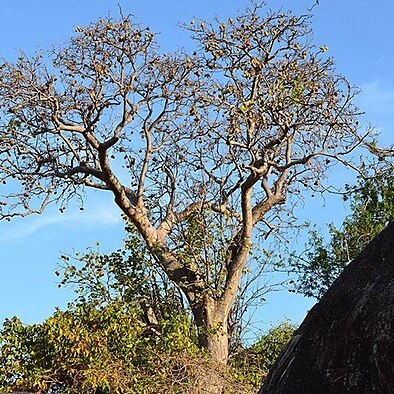Leaf-lamina 5–15 × 4–13 cm., very broadly ovate-cordate, apex acuminate, almost entire or 3–5-lobed with somewhat acuminate lobes, c. 7 nerved at the base, from thinly to densely and harshly pubescent or tomentose, sometimes glabrescent; petiole up to 10 cm. long, coarsely pubescent.
Flowers in clustered, usually terminal panicles appearing before the leaves and up to 9 cm. long; branches of inflorescence densely pubescent; bracteoles c. 1·5 mm. long, linear-oblong, acute, pubescent; pedicels up to 1 cm. long, articulated near the middle, pubescent.
Tree 10–25 m. tall, with a stout trunk up to 1 m. in diam. somewhat resembling that of the Baobab; bark peeling in papery flakes, brownish, yellowish, whitish or liver-coloured, inner layers green and with the sapwood pink; primary branches stiff and very stout.
Follicles 3–5, c. 10 cm. long, spreading, subsessile, oblong-ovoid, with a horn-like often curled apiculus at the apex, golden-tomentellous and finely longitudinally ridged outside, opening widely after dehiscence; placentas with very dense acicular hairs.
Calyx up to 1·2 cm. long, yellowish with reddish guide-lines within, campanulate, divided rather more than half way into 5–6 acute lobes, tomentellous outside, glabrous within except near the apex.
Female flower: ovary ovoid, tomentose, with a few vestigial stamens at its base, on a puberulous gynophore c. 4 mm. long; style c. 3 mm. long, pubescent, often reflexed.
Seeds numerous, c. 2 × 1 cm., oblong-ellipsoid, with a whitish aril at one end; testa smooth, dull-blackish.
Male flower: stamens c. 10, in a capitate discoid cluster; androphore 5–6 mm. long, slender, glabrous.
Leaves collected at the ends of the branches.


